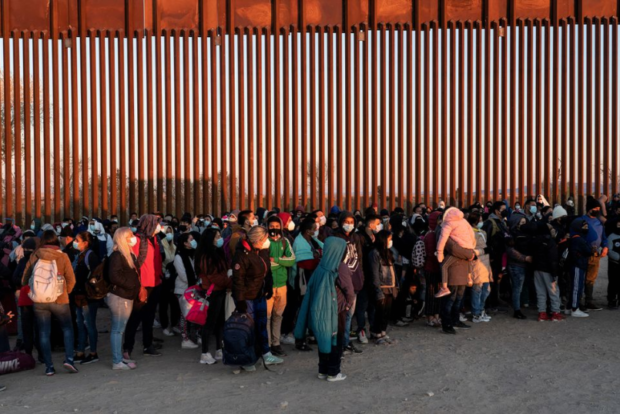
Migrants seeking asylum in the U.S., mostly from Venezuela, stand near the border fence while waiting to be processed by the U.S. border patrol after crossing the border from Mexico at Yuma, Arizona, U.S., January 23, 2022. REUTERS
WASHINGTON — U.S. officials are preparing for the possibility of thousands of more migrants per day attempting to cross the U.S.-Mexico border without authorization, a pace that could shatter last year’s record-breaking levels, as the Biden administration weighs lifting a COVID-era order currently blocking most asylum seekers.
The U.S. Department of Homeland Security (DHS) is readying for as many as 18,000 migrants per day in the coming weeks, but also preparing for a smaller increase to 12,000 arrivals per day or arrivals similar to current levels, an agency official said during a Tuesday call with reporters, requesting anonymity to discuss internal matters.
The official did not provide the current number of migrant encounters at the border each day. As of mid-March, around 5,000 migrants were arriving per day on average, two separate U.S. government sources told Reuters at the time.
Another DHS official on the same call said it remained unclear whether lifting the COVID-era order would increase migration, but preparations were underway anyway.
U.S. health officials face a deadline this week to renew, modify or terminate the so-called Title 42 COVID-19 health order. The order was implemented in March 2020 by the U.S. Centers for Disease Control and Prevention (CDC) during the administration of former Republican President Donald Trump to limit the spread of the virus. U.S. President Joe Biden, a Democrat, has so far kept it in place.
Under Title 42, U.S. border agents can “expel” migrants to Mexico within hours or rapidly send them to other countries without the opportunity to seek asylum in the United States.
Health experts, immigrant rights advocates and leading Democrats argue the policy unlawfully cuts off access to asylum and puts migrants in danger in Mexico, and that scientific evidence does not support its stated goal of helping to curb the spread of the virus. They have chastised Biden for keeping it in place despite promises to roll back Trump’s most restrictive immigration policies.
Republicans across the country have made rising illegal immigration at the U.S.-Mexico border a major attack line heading into the Nov. 8 congressional election, where Democrats risk losing control of Congress, stymieing Biden’s legislative agenda.
Reuters reported earlier this month that Biden officials were leaning toward ending the order after court decisions complicated its usage and U.S. health officials moved to loosen pandemic restrictions nationwide more broadly. DHS said on Monday that it had started giving COVID-19 vaccines to migrants in custody at the border.
The Biden administration has said the decision to lift the order lies with CDC, which declined to comment.
Increased federal staffing
DHS officials told congressional offices earlier this month that tens of thousands of migrants who are already near the border could arrive within hours of Title 42 being lifted and more than 1 million in southern Mexico and other countries could come within weeks, according to an aide briefed on the matter.
DHS did not respond to a request for comment on those estimates.
The planning effort involves building additional temporary holding facilities along the border, some of which will be ready for use by early April, one of the DHS officials said on Tuesday’s call. DHS is also working to add more staffing and transportation, in an effort that involves multiple federal agencies that work with immigrants, the person said.
The Federal Emergency Management Agency (FEMA), an emergency agency that usually responds to floods, storms and other major disasters, is assisting with the planning effort, although the administration has not formally issued a disaster declaration.
DHS is working on a system that would allow migrants seeking asylum to register electronically and schedule a time to approach a legal port of entry as part of a “more orderly process,” one of the DHS officials said.
Some asylum seekers have been stranded in Mexico for months waiting for the restrictions to be lifted. Reuters interviewed five LGBTQ asylum seekers from Jamaica stuck in Tijuana, Mexico in recent weeks, some of whom said they had resorted to prostitution because they could not work legally and faced discrimination in Mexico.
RELATED STORIES
US-Mexico border reopens after 20 months of COVID shutdown
US and Canada fear economic damage from border crossing protest
International travelers head to the United States as flights reopen
US expects delays, long lines when COVID-19 travel restriction lifts, official says